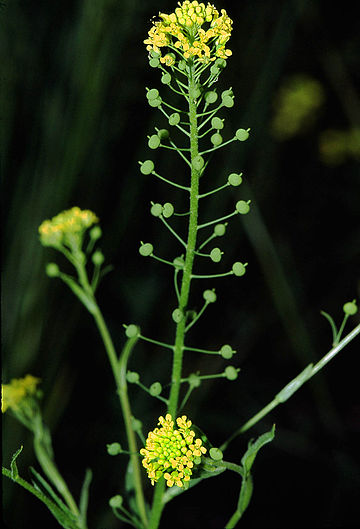Neslia is a monotypic plant genus in the family Brassicaceae.[2] The only extant species is Neslia paniculata (L.) Desv.[3]
| Neslia | |
|---|---|
 | |
| Scientific classification | |
| Kingdom: | Plantae |
| Clade: | Tracheophytes |
| Clade: | Angiosperms |
| Clade: | Eudicots |
| Clade: | Rosids |
| Order: | Brassicales |
| Family: | Brassicaceae |
| Genus: | Neslia Desv. |
| Species: | N. paniculata |
| Binomial name | |
| Neslia paniculata (L.) Desv. | |
| Synonyms | |
|
Myagrum paniculatum L.[1] | |
Neslia paniculata
Neslia paniculata (commonly called ball mustard) is a plant species in the family Brassicaceae. The name comes from the ball-shaped fruits that contain a single seed within an indehiscent fruit coat.[4] It is an annual where the seeds germinate in autumn to winter and grow into a flattened rosette of leaves that develop vertical flowering stems in the spring. These can be up to 1 metre tall. The flowers open in late spring/early summer and the seeds are mature by summer.[5]
It is a native plant of temperate regions of Eurasia.[6] It can also be found in much of the northern and southern regions of the Americas, Australia and also Britain.[7][8] It is considered a weed in many of these regions introduced from agricultural seed and can be a problem in cereal and especially other brassica crops. Its seed pods can contaminate harvests of mustard and rape/canola, even after cleaning. At the other end of the spectrum, within some its original region it has become a threatened or rare arable plant as a consequence of improved agricultural practices.[4]
References
Wikiwand in your browser!
Seamless Wikipedia browsing. On steroids.
Every time you click a link to Wikipedia, Wiktionary or Wikiquote in your browser's search results, it will show the modern Wikiwand interface.
Wikiwand extension is a five stars, simple, with minimum permission required to keep your browsing private, safe and transparent.



